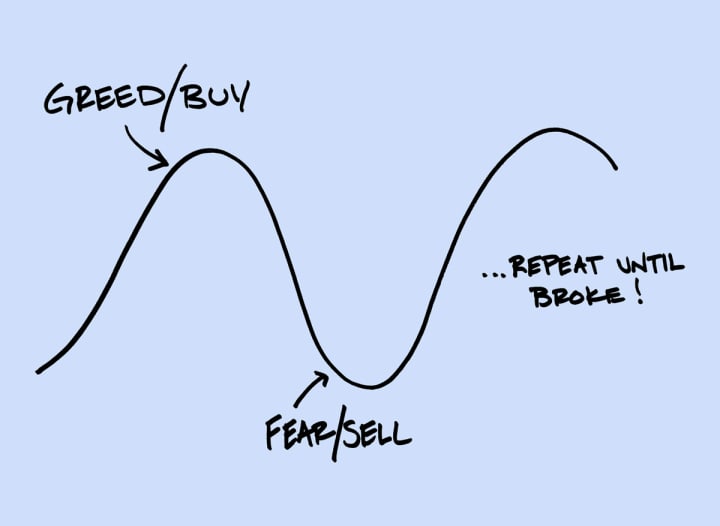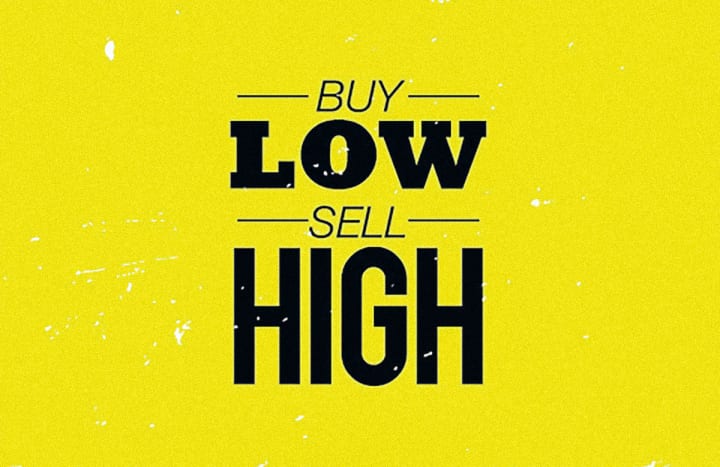What Is the Puke Point?
Brush up on your business lingo with this quick lesson on Puke Points, shorting, and financial disaster.
If you know much about trading and investing market and stock shares, then you’ll know the “puke point” is the dark, bleak horror land that no investor ever wants to reach... but likely will eventually. At the very best, hitting the puke point means a really crappy day in the market. At worst, the puke point spells out financial ruin for traders or investors who put too many eggs in one shaky basket.
What Exactly Is the Puke Point?
The puke point happens when the value of a certain stock plummets so far down that you can’t get rid of those cursed shares fast enough. That point where you just want to sell sell sell, even at a major loss, in order prevent losing MORE, is the puke point. Yes, it’s a very lovely mental image…
The term “puke point” started popping up on the Internet around 15 years ago. It originated with Virginia-local investment analyst Dennis Gartman. The phrase was attributed to him, and then widely quoted by financial author A. Gary Schilling. All the financial writers who have used this term agree from experience that an investor feels like physically puking when he has to sell his shares at a loss just as a form of damage control.
Short Positions, Long Positions, and the Big Short

Screenshot from The Big Short
Paramount’s The Big Short (2015), starring Christian Bale, Steve Carrell, Ryan Gosling, and Brad Pitt, is a movie of one of the most colossal short-sells in recent history. First, some Trading 101 is required. A short position includes selling borrowed shares of stock, or securities, or currencies, etc.
An investor will borrow a company’s stock shares and sells them, pocketing the money at the price of an interest rate paid to the lender. He expects the value of those shares to go down soon. Once they go down, he’ll buy them back up and return them to the lender. If the money he spent buying the shares back, plus the interest rate paid, add up to less than what he first sold the borrowed stock for, then he made a profit from the short position. He made money from someone else hitting the puke point and selling those shares back to him.
In The Big Short, Christian Bale plays daring hedge fund manager Michael Burry, who figures out the extreme instability of the U.S. housing market. He figures out that the rise of adjustable interest rates on subprime mortgages will go up and countless homeowners will default and the housing market will collapse. To profit from this, he sets up a market for trading credit default, which no one else thinks will make money. Burry doesn’t quite literally make a short sell, but he does so figuratively. When the housing market collapses, his portfolio rises in value by nearly 500%. In short, Burry makes $2.5 billion betting on home loans to go into default and big banks to hit the puke point (which is why they wanted to be bailed out by TARP).
Long Positions and Reaching the Puke Point?
Reaching the puke point all depends on the individual’s threshold of pain. Keep in mind that everyone has a different threshold for the amount of losses they are ready to incur. Some people are deathly loyal to a stock like they’re loyal to a brand. Take Nintendo or Apple, for example. If you look at their quarterly and annual revenue reports, 2015 was a way better fiscal year for Apple than 2016 was, and the value of individual shares went down 40 cents.
Anyone who had a small fortune invested in shares of Apple, expecting that bundle of shares to be the geese that lay the golden eggs, probably had a bad time. If they felt that they had too much money tied up in Apple shares, then they no doubt reached the puke point. Somebody else with more money, a more diversified asset portfolio, and perhaps some healthy long-term optimism would have had a higher threshold for pain.
Then again, there’s probably someone out there who’s already reached the puke point, but is suffering in silence until the iPhone 8 comes out, redeems the Apple stock, and gives him an opportunity to sell his shares at a profit. This is an example of a long position.
The Market’s Messing with you, Dude!

The market is highly unpredictable. There are times when the market might send a particular stock plummeting. It might even hit the puke point, recover, and hit the puke point again more than once in a day. Take a look at an example from 2012 that Kid Dynamite eloquently presents on his investing blog:
On September 19, 2012 JC Penney’s stock started the day off at 29.09 per share. Before 10 AM it had climbed to over 30, and by 10:30 it had dropped down below 29 where it started. It hovered around the low 29 zone for hours until suddenly taking off after 3:30 PM and peaking above 32. This would have been the perfect time to sell at a profit.
Then, shortly after it had peaked above 32, JC Penney’s stock plummeted dramatically back down to the low 29 zone. When the trading day ended, JC Penney was at 28.73, 36 points lower than it had started that morning. The dramatic plunge that horrified shareholders between 3:30 and 4 PM definitely waltzed straight to the puke point.
Puking all over Europe
One recent event that triggered a lot of puking in the European market was the recent Brexit vote, where Great Britain voted to withdraw from the European Union. As late as June 24, 2016, the Dow Jones industrial average futures were predicting a 650 point plunge following the UK’s decision to withdraw from the EU.
The British pound dropped 10% overnight. If that had actually happened, it would have been the sixth lowest plunge the Dow Jones ever took. The four other instances happened during the 2007-2009 nightmare of a bubble burst. Another happened in 2001 during the dotcom bubble burst.
The S&P 500 futures predicted a bigger drop, saying that the market would be down by 5% the Friday after Brexit, instead of the 4% drop predicted by the Dow futures. It turned out not to be that bad, and neither Europe nor the USA have tumbled into an economic depression over Brexit. Still, the market opened up to a rocky start and a whole lot of stocks hit the puke point for their owners that day.
The People Who Lurk at the Bottom

Not everybody lost out when the American market took a punch to the gut. Actually, some traders and investors were eager to capitalize on this opportunity. When the market is highly volatile, it’s likely that some companies will lose money and their stock values will plummet. Others have better luck, though.
When certain stocks plummet, there are eager parties waiting to swoop up those shares while they’re nice and cheap, knowing fully well those stocks will go back up again soon and can be sold at a profit. Even Investopedia recognizes that certain traders specifically wait for certain stocks to hit the puke point, when they can snag up a great bargain that will make money again soon.
If you want to see a depiction of people reaching the puke point en masse, then Paramount’s The Big Short is highly recommended. The cast is solid and the writing is good. The evidence is in the cast’s ability to monologue about solid economic theory while still delivering convincing performances. If you’re a trader considering either short positions or long positions, talk with an expert about hitting the puke point so you can limit its chances of happening to you.
About the Creator
Zach Foster
Freelance writer. Served as a reserve soldier. Occasionally works as a private contractor. Senior Contributor for the Libertarian Party of Nevada blog.





Comments
There are no comments for this story
Be the first to respond and start the conversation.